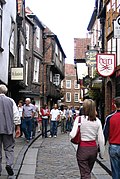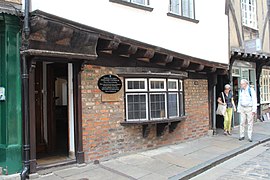The Shambles
 Looking south towards the intersection of Shambles and Little Shambles, 2018 | |
 Location within York | |
| Former name(s) |
|
|---|---|
| Length | 400 ft (120 m) |
| Location | York, England |
| Coordinates | 53°57′33.85″N 1°4′48.40″W / 53.9594028°N 1.0801111°W |
| North end | Newgate, York |
| South end | Pavement, York |
The Shambles is a historic street in York, England, featuring preserved medieval buildings, some dating back as far as the 14th century. The street is narrow, with many timber-framed buildings with jettied floors that overhang the street by several feet. It was once known as The Great Flesh Shambles, probably from the Anglo-Saxon Fleshammels (literally flesh-shelves), the word for the shelves that butchers used to display their meat. In 1885, thirty-one butchers' shops were located along the street,[1] but none remain today.
Etymology
"Shambles" is an obsolete term for an open-air slaughterhouse and meat market. Streets of that name were so called from having been the sites on which butchers killed and dressed animals for consumption (One source suggests that the term derives from "Shammel", an Anglo-Saxon word for shelves that stores used to display their wares,[2] while another indicates that by AD 971 "shamble" meant a 'bench for the sale of goods' and by 1305, a 'stall for the sale of meat'.).[3]
The area around the Shambles was known as Marketshire into the 14th century and included the streets of the Shambles and Pavement. The Shambles itself had several names: by 1240 it was referred to as Haymongergate, and it was called Nedlergate in 1394, both thought to be references to other trades and crafts which took place in the street. In addition to these names, by 1426 it had become more commonly known as The Great Flesh Shambles, which was eventually shortened to its current name.[4][5]
There are streets named "The Shambles", or "Shambles Street", in other UK towns and cities, including Barnsley, Bradford on Avon, Chesterfield, Guildford, Swansea, Chippenham, Manchester, Sevenoaks, Whitby, Worcester and Armagh. There is also a Fishamble Street in Dublin, Ireland.
History

Although not named in the Domesday Book of 1086, it has been identified through an entry which lists two butchers' stalls near the church of St Crux (ii bancos in macello nr ecclesiam St Crucis) being in the ownership of the Count of Mortain.[4][5]
The naming of the street after butcher stalls has stuck since the 14th century because the association of the street with butchers has been a large part of its history and character. This was because of a continuous tradition of butchers occupying the street that was upheld for centuries. This is probably in large part due to the favourable architecture of the street towards butcher practices of centuries past. The rears of the shops were slaughterhouses and the fact the buildings shade the narrow street from direct sunlight meant that the meat on display could stay fresh for longer. Also, when butchering took place, the guts, offal and blood were thrown into the street runnels that had a natural slope which helped it wash away after rain. These butchering practices long predated basic modern standards of hygiene and the street would have been incredibly unhygienic in these days. The last butcher shops on the street closed in the early 20th century and although the butchers have now vanished, a number of the shops on the street still have meat-hooks hanging outside and, below them, shelves on which meat was displayed. The shops include restaurants and shops as well as a bookshop and a bakery.[6]
In medieval times, many streets in York had a similar appearance to the Shambles, such as The Water Lanes.[5] The Shambles preserves a large amount of original medieval-built fabric, with many buildings dating from circa 1350–1475.[2] Along with this, the picturesque qualities of the narrow street with its timber-framed jettied houses have meant that, since as early as the 19th century, it has been recognised as a major attraction of the city of York.[6]
The 1940s and 1950s were a period when the Shambles was subject to a lot of change. After the Second World War, the street was targeted by city planners who wanted to make improvements to the buildings which by that time were in urgent need of restoration. York City Council purchased numerous properties from private owners and, during the 1950s, they extensively altered and rebuilt many buildings and demolished large sections of the area, including the entirety of Little Shambles, a short street that led west off the centre which was considered to be beyond repair. A chapel called Holy Trinity Christ Church was at the heart of King's Square until it was demolished in 1937.[7] Today, some of these restorations are seen as insensitive, since a great deal of historic fabric, including slaughterhouses and outbuildings at the rear of the properties, was demolished. The Yorkshire Architectural and York Archaeological Society's annual report of 1949 contains plans of The Shambles showing the buildings to be removed.[8]
There are five "snickelways" that lead off the Shambles because they used to be small alleyways in the backs of the buildings, but since these back buildings were demolished in the 1950s, they now open out onto a big open space with market stalls known as Shambles Market. The market was previously known as Newgate Market, after the street on which it is located, but was renamed in 2015.[6]
The Shambles is one of a number of locations, along with streets in Chepstow, Edinburgh, Exeter and London, for which claims have been made to have been the inspiration for Diagon Alley in the Harry Potter franchise.[9] Since 2017, four wizard-themed shops have opened in the street;[10] however, the author, J. K. Rowling, has denied this, stating that she had never been to The Shambles.[11]
Notable buildings

Almost all the buildings on the street are listed. On the east side, 1 Shambles is timber-framed and probably 14th century; 2 Shambles is early 18th century; and 3–5 Shambles are all 19th century, one initially serving as the former Shoulder of Mutton pub. 6 Shambles is late 18th century, with a 20th-century renovation and shopfront. 7–8 Shambles are late and early 15th century, respectively; and 9 Shambles is also 15th century. 10–11 Shambles originated as one 15th-century house; and 12 Shambles has some parts probably dating from the 14th century. 13 Shambles is early 16th century, while 14 Shambles was originally timber-framed but of unclear date. 19 Shambles was built in the early 16th century; 20 Shambles is mid-18th century; and 21–23 Shambles were each built in the early 18th century. At the end of the street is the parish room of St Crux.[5]
On the west side, 27–28 Shambles were built in the early 19th century; 30 Shambles is 18th-century but largely rebuilt in 1952; and 31–33 Shambles were built as a terrace in about 1436.
Among the structures of The Shambles is a shrine to Saint Margaret Clitherow, who was married to a butcher who owned and lived in a shop in the street. Her home is thought to have been number 10 Shambles, on the opposite side of the street to the shrine, at number 35, which has a priest hole fireplace.[12][13][14] These are also listed.[15] 37–38 Shambles are late-15th century; and 39 Shambles includes a 15th-century timber frame. 40 Shambles is early-18th century; 41–42 Shambles is 15th century; and 43 Shambles was built in 1775. 44 Shambles is 15th century; 45 Shambles is early-18th century; and 46–47 Shambles were built in about 1740.[5]
Gallery
-
A view from 1985, looking south towards Pavement
-
Jettied buildings overhang the street by several feet
-
The Shambles is now a tourist destination, 2005
-
The shrine to Saint Margaret Clitherow, 2018
-
The Shambles by night, 2009
See also
References
- ^ Directory of York and Neighbourhood. London: George Stevens. 1885. p. 231. Retrieved 8 June 2021 – via University of Leicester: Special Collections Online.
- ^ a b "The Shambles: History of York". www.historyofyork.org.uk. Retrieved 18 June 2018.
- ^ Martin, Gary. "'A complete shambles' - the meaning and origin of this phrase". Phrasefinder. Retrieved 18 June 2018.
- ^ a b "Shambles". York Civic Trust. Retrieved 6 June 2020.
- ^ a b c d e "Houses: Shambles-The Stonebow". An Inventory of the Historical Monuments in City of York, Volume 5, Central. London. 1981. pp. 212-220. Retrieved 6 June 2020 – via British History Online.
{{cite book}}: CS1 maint: location missing publisher (link) - ^ a b c "26 reasons why Shambles Market will change York for good". YorkMix. 22 March 2015. Retrieved 29 May 2019.
- ^ "The lost church of King's Square | York Stories". Retrieved 5 July 2022.
- ^ "Shambles – York Civic Trust". yorkcivictrust.co.uk. Retrieved 27 June 2022.
- ^ Lovell, Jane (25 March 2019). "Fairytale authenticity: historic city tourism, Harry Potter, medievalism and the magical gaze". Journal of Heritage Tourism. 14 (5–6): 448–465. doi:10.1080/1743873X.2019.1588282. S2CID 194654913.
- ^ "I'm sick of all these Harry Potter shops on the Shambles". Nouse. 30 October 2018. Retrieved 29 May 2019.
- ^ Pocock, Emma. "J.K. Rowling Debunks 'Harry Potter' Inspiration Claims". Forbes. Retrieved 12 February 2023.
- ^ "About us". Cuffs & Co. Archived from the original on 4 October 2018. Retrieved 3 October 2018.
- ^ "The Pearl of York". BBC News. 9 October 2008. Retrieved 3 October 2018.
- ^ Historic England. "10 and 11, Shambles (1256676)". National Heritage List for England. Retrieved 29 May 2019.
- ^ "Search results: Shambles York (30 records found)". Historic England. Retrieved 7 June 2020.
Sources
- Pevsner, Nikolaus; revised by Neave, David (1995) [1972]. The Buildings of England Yorkshire: York and the East Riding (2nd ed.). Harmondsworth: Penguin Books. ISBN 978-0-14-071061-8.
External links
- CS1 maint: location missing publisher
- Articles with short description
- Short description is different from Wikidata
- Use dmy dates from July 2022
- Use British English from October 2017
- Infobox mapframe without OSM relation ID on Wikidata
- Coordinates on Wikidata
- Articles containing Latin-language text
- Commons category link is on Wikidata
- The Shambles
- Tourist attractions in York
- Timber framed buildings in Yorkshire
- Butcher shops
- Pages using the Kartographer extension




